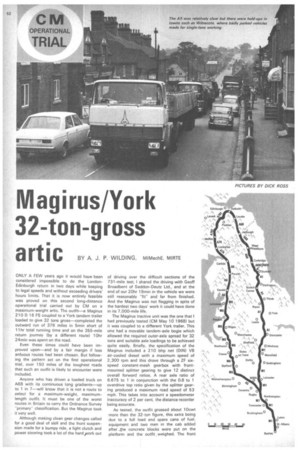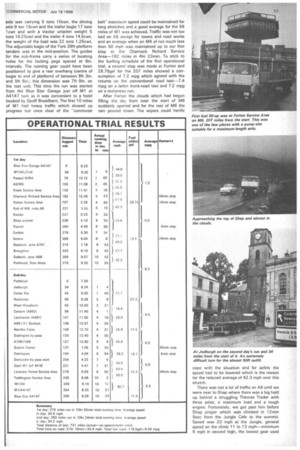Magirus/York 32-ton-gross artic
Page 54

Page 55

Page 56

If you've noticed an error in this article please click here to report it so we can fix it.
BY A. J. P. WILDING, MIMechE,
MI RTE
ONLY A FEW years ago it would have been considered impossible to do the LondonEdinburgh return in two days while keeping to legal speeds and without exceeding drivers' hours limits. That it is now entirely feasible was proved on this second long-distance operational trial carried out by CM on a maximum-weight attic. The outfit—a Magirus 210 D 16 FS coupled to a York tandem trailer loaded to give 32 tons gross—completed the outward run of 376 miles in 5min short of 11 hr total running time and on the 355-mile return journey (by a different route) 10hr 24min was spent on the road.
Even these times could have been improved upon—and by a fair margin if less arduous routes had been chosen. But following the pattern set on the first operational trial, over 150 miles of the toughest roads that such an outfit is likely to encounter were included.
Anyone who has driven a loaded truck on A68 with its continuous long gradients—up to 1 in 7—will know that it is not a route to select for a maximum-weight, maximumlength outfit. It must be one of the worst routes in Britain to carry the Ordnance Survey "primary" classification. But the Magirus took it very well.
Although making clean gear changes called for a good deal of skill and the front suspension made for a bumpy ride, a light clutch and power steering took a lot of the hard pork out of driving over the difficult sections of the 731-mile test. I shared the driving with Geoff Broadbent of Seddon-Deutz Ltd., and at the end of our 20hr 19min in the vehicle we were still reasonably "fit" and far from finished. And the Magirus was not flagging in spite of the hardest two days work it could have done in its 7,000-mile life.
The Magirus tractive unit was the one that I had previously tested (CM May 10 1968) but it was coupled to a different York trailer. This one had a movable tandem-axle bogie which allowed the required outer-axle spread for 32 tons and suitable axle loadings to be achieved quite easily. Briefly, the specification of the Magirus included a 210 bhp net (DIN) V8 air-cooled diesel with a maximum speed of 2,300 rpm and this drove through a ZF sixspeed constant-mesh gearbox with frontmounted splitter gearing to give 12 distinct overall forward ratios. A rear axle ratio of 6.675 to 1 in conjunction with the 0.8 to 1 overdrive top ratio given by the splitter gearing produced a maximum road speed of 53 mph. This takes into account a speedometer inaccuracy of 2 per cent, the distance recorder being accurate.
As tested, the outfit grossed about 10cwt more than the 32-ton figure, this extra being due to a full load and spare cans of fuel, equipment and two men in the cab added after Ahe concrete blocks were put on the platform and the outfit . weighed. The front axle was carrying 5 tons 10cwt, the driving axle 9 ton 15cvvt and the trailer bogie 17 tons 1cwt and with a tractor unladen weight 5 tons 14.25cwt and the trailer 4 tons 14.5cwt, the weight of the load was 22 tons 1.25cyvt. The adjustable bogie of the York 39ft-platform tandem was at the mid-position. The guides for the sub-frame carry a series of locating holes for the locking pegs spaced at Gin, intervals. The running gear could have been positioned to give a rear overhang (centre of bogie to end of platform) of between 9ft 3in. arid 5ft 9in.; this dimension was 7ft 91n. on the test unit. This time the run was started from the Blue Star Garage just off M1 at A4147 turn as it was convenient to a hotel booked by Geoff Broadbent. The first 10 miles of M1 had heavy traffic which slowed up progress but once clear of the "commuter belt" maximum speed could be maintained for long stretches and a good average for the 56 miles of M1 was achieved. Traffic was not too bad on A5 except for towns and road works and an average when on M6 of not much less than 50 mph was maintained up to our first stop at the Charnock Richard Service Area-182 miles in 4hr 23min. To stick to the fuelling schedule of the first operational trial, a second stop was made at Forton and 28.75gal for the 207 miles showed a consumption of 7.2 mpg which agreed with the returns on the conventional road test-74 mpg on a laden trunk-road test and 7.2 mpg on a motorway run.
After Forton the clouds which had begun filling the sky from near the start of M6 suddenly opened and for the rest of M6 the rain poured down. The wipers could hardly cope with the situation and for safety the speed had to be lowered which is the reason for the reduced average of 42.3 mph over this stretch.
There was not a lot of traffic on A6 until we were near to Shap where there was a big hold up behind a struggling Thames Trader with three axles, a maximum load and a rough engine. Fortunately, we got past him before Shap proper which was climbed in 12min 5sec from the Jungle Cafe to the summit. Speed was 20 mph at the Jungle, general speed on the climb 11 to 13 mph-minimum 9 mph in second high, the lowest gear used —and at the top road speed was 12 mph. Traffic conditions in Penrith and Carlisle were atrocious as usual—I cannot understand how the main route to Scotland running through these two towns has been tolerated for so long but a welcome sign is the by-pass work which is going on.
Gretna and Scotland were reached after a total running time of 8hr 8min {289 miles) and a fill-up showed the consumption over the more severe section had not dropped too much at 6.0 mpg. After Gretna the road is better. For the 20-odd miles before Beattock there is good quality dual carriageway and this extends almost to the outskirts of Glasgow. Arriving at Beattock at 8.53, I would estimate that we could have been in Glasgow in a further 1-ihr making the total running time less than 100r. But to get more difficult country we took A701 across the Tweedsmuir hills. The rain was still falling, calling for care on the many tight bends and restricting speed to some extent but an average of almost 28 mph was achieved up to Dalkeith. Turning south here on to A66—an easy part of it —saw the average increased to 32.2 mph up to our overnight stop at Pathhead 376 miles in 10hr 55min running time for an average speed of 34.5 mph.
The A68 is not too bad up to West Woodburn but over the next 31 miles there is a need for frequent gear changing with numerous hills of all shapes and sizes—we did well to get 18.6 mph over this stretch of 30 miles up to Consett. The severity of the road is responsible for consumption being 4.6 mpg from Rochester to Al as compared with 5.3 mpg on the run across Scotland and from Dal keith.
The plan had been to continue on A68 to the Darlington by-pass but a diversion at Castleside to avoid a weak bridge took us through Consett with no signs to lead us back on to A68 and no reasonable-looking ways on the map. So from A692 we took A691 to the outskirts of Durham to pick up Al and start the "downhill" run home. Traffic kept the average down but once clear of the poorer section of Al we built up to around 40 mph. The weather had been bad for most of the morning but blue skies were ahead. Soon we were on the motorway and it is interesting that the northern half of M1 is that much more severe than the southern half to have made a difference of 7 mph in average speeds. But the fuel consumptions were very consistent for the last 250 miles at around 6.5 mpg, We got back to the start after 10hr 40min on the road (355 miles) giving an average speed of 34.2 mph and the average for the total run of 34.4 mph. Total fuel used in the two days was 118.3gal for 6.28 mpg_ The main criticism I have of the Magirus is in respect of the bouncing ride. Spring seats are supplied for both the driver and passenger and while these are essential, they do not make for a complete answer: there is no jarring but still a lot of up-and-down movement.
A change made to the gear change layout since I tested the model has improved things considerably. Instead of top and fifth positions being remote from the driver—and a fair stretch—they are now on the driver's side of the gate with first and second away from him. It took a long time to master a technique to make clean changes and this I felt to be due to variable spacings between each of the forward gears. Some were fairly easy but using the same difference in engine speed for other changes was unsuccessful. As a result, the gearbox came in for more punishment than in more experienced hands.
I found it best to work around an engine speed of 2,000 rpm when going, up in the gearbox, not running up to maximum engine speed. It was better when on long upward gradients that allowed changes to a higher gear to go to about 2,200 rpm in the lower gear which gave about 1,700 after a split change to a higher ratio. When changing down on some gradients it was useful to make split changes but on most this was not worth while except in top and fifth.
The mirrors on the Magirus are good and in the heavy rain and later on wet roads, did not get fouled up by spray too quickly. When it was necessary to clean off the water the driver's mirror was easily reached from the seat. The wipers did a lot of work and performed their task well but the demisting equipment was not able to keep the inside of the screen clear of moisture in the conditions.




















































































































